What is Cha-no-yu?
Qu’est-ce que le Cha-no-yu ?
It has been 500 years since the style of “Cha-no-yu” was established.
Aesthetics of Chajin and various tools that embody stylistic beauty of them are introduced.
L’art de la cérémonie du thé a été établi il y a 500 ans.
Nous vous présentons différents types d’ustensiles incarnant l’esthétique stylistique recherchée par de grands Chajins.
History of Cha-no-yu
During the Heian period, the culture of tea drinking was inherited by the aristocracy and monks, but the amount produced was still too small to be available to the ordinary people.
In the Kamakura period, Eisai brought tea plants back from China and spread the culture of tea drinking. As the production of tea increased, tea became popular among the Samurai.
In the Muromachi period, the game of "fighting tea," in which players had to guess the type of tea, became popular, and the rooms were decorated with luxurious items. As the amount of tea produced increased further, the custom of tea drinking spread to the ordinary people. The custom of "Rinkan-Cha-no-yu", in which local people were invited to the baths to eat and drink tea, was also established, and eventually "Cha-no-yu" was born, as represented by the townspeople of Sakai.
During the period of war, "Cha-no-yu" was popular among Samurai as a game to relieve the tension of battle and to maintain mental balance. It was during this time that the genius tea master Sen no Rikyu was born.
In the Edo period, the study of Cha-no-yu became a part of employment for samurai. Throughout the Edo period, Cha-no-yu came to be regarded as the education of Samurai.
Cha-no-yu, which had already developed its form during the period of war, began to attract attention to this hobby in the direction of collecting tools.
Since the Meiji era, Cha-no-yu has been a part of women's education. Cha-no-yu, which had traditionally been a culture of men, began to develop into an educational culture for women.

Histoire du Cha-no-yu
La consommation du thé a été introduite au Japon durant l’époque de Heian par des « étudiants » revenant de Tang (Chine). L’empereur Saga a apprécié ce thé et a ordonné de cultiver du thé et d’en fournir à la Cour.
À l’époque de Heian, les aristocrates et les moines bouddhistes consommaient du thé mais la production étant si faible, la classe populaire ne pouvait en boire.
À l’époque de Kamakura, Eisai a ramené des arbres à thé depuis Song (Chine). La production de thé a ainsi augmenté et sa consommation s’est répandue dans la noblesse militaire.
À l’époque de Muromachi, est devenu à la mode le jeu appelé Tocha qui consiste à deviner la variété du thé par son goût. Ce jeu était organisé dans des pièces décorées d’objets luxueux. La multiplication de la production de thé a permis à la classe populaire d’en consommer. On a commencé le Rinkan-Cha-no-yu (inviter des voisins à manger et boire du thé dans sa salle de bain). Des artisans et commerçants de Sakai ont établi le Cha-no-yu.
À l’époque Sengoku (= époque des provinces en guerre), le Cha-no-yu était pratiqué par des Samouraïs cherchant à se détendre entre deux guerres et à avoir un équilibre psychologique. C’est dans ces circonstances que Sen no Rikyu est né, un génie du thé.
À l’époque d’Edo, le Cha-no-yu faisait partie des atouts pour se faire embaucher et de la culture générale chez les Samuraïs.
Le Cha-no-yu dont la méthode de préparation du thé a été établie à l’époque Sengoku a pris un nouvel essor avec la collection d’ustensiles pour le thé.
Après la restauration de Meiji, le Cha-no-yu qui était jusqu’alors pratiqué par les hommes été introduit dans le programme d’instruction des filles.
Kamakura era |
Époque de Kamakura
In 1191, Eisai brought a new method of tea drinking back to Japan from China.
Tea culture spreads to Japan.
At the end of the Kamakura period "Tocha", a tea drinking game, became popular among Samurai.
En 1191, Eisai qui revenait de Song (Chine) a introduit un nouveau mode de consommation du thé. La consommation du thé a ainsi commencé au Japon. Au début du 14ème siècle, le jeu appelé Tocha qui consiste à deviner la variété du thé par son goût est devenu à la mode dans la noblesse militaire.
Muromachi era |
Époque de Muromachi
En 1467, la ville de Kyoto a été détruite au cours de la guerre d’Onin. Sakai a alors connu un grand développement.
Juko a fondé le Cha-no-yu. (Naissance du Wabicha)
Azuchi-momoyama era |
Époque Sengoku, Époque Azuchi-Momoyama
In 1522, Sen no Rikyu is born (a great master of Wabicha).
Oda Nobunaga conducts a "Masterpiece Hunt" to collect masterpieces of tea ceremony tools.
Sen no Rikyu becomes the head of the tea ceremony for Toyotomi Hideyoshi.
In 1586, Hideyoshi builds the "Golden Chashitsu”.
In 1591, Rikyu was ordered by Hideyoshi to commit harakiri.
En 1522, Sen no Rikyu est né (et perfectionnera le Wabicha).
Oda Nobunaga a organisé « Meibutsu-gari » (la chasse aux chefs-d’œuvre d’ustensiles du thé).
Sen no Rikyu a été nommé premier maître de thé.
En 1586, Toyotomi Hideyoshi a construit une Chashitsu dorée.
En 1591, Rikyu s’est donné la mort suite à un ordre de Toyotomi Hideyoshi.
Edo era | Époque d’Edo
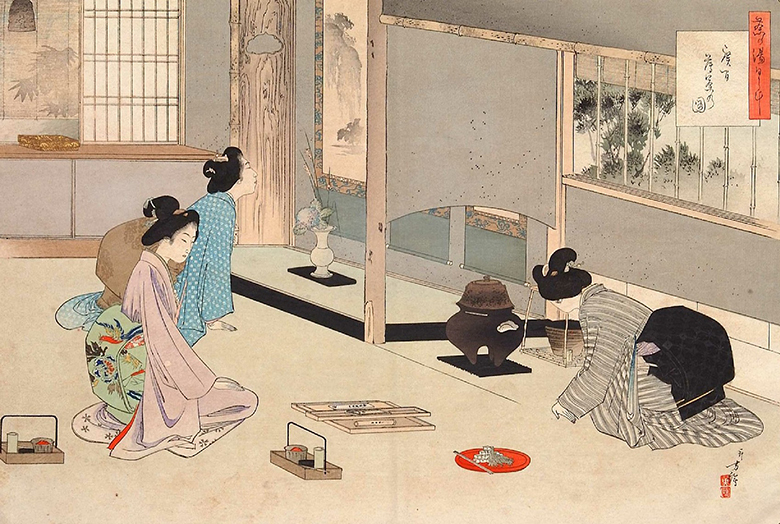
Meiji era – Taisho era |
Ère Meiji - Ère Taisho
With the Meiji Restoration, Sado (=Cha-no-yu) temporarily declined.
Cha-no-yu was revived by business leaders who collected famous tools.
With the arrival of Western civilization in Japan, the Urasenke introduced the "Ryureishiki", doing Temae with a table and chairs.
Okakura Tenshin publishes "The Book of Tea" in New York.
Cha-no-yu was introduced to women's education.
Après la restauration de Meiji, le Cha-no-yu a décliné pendant un moment mais la chasse aux Meibutsu (chefs-d’œuvre) lancée par des hommes d’affaires a donné un nouvel essor au Cha-no-yu.
Avec l’influence de la culture européenne, l’école Urasenke a inventé le style Ryureishiki (avec table et chaises).
Après la publication par Okakura Tenshin du livre intitulé « The Book of Tea » à New York, le Cha-no-yu a été introduit dans le programme d’instruction des filles au Japon.
Sen no Rikyu (1522-1591)
The 16th century in Japan, the era in which Sen no Rikyu lived, was a time of war, but culturally it was a time of abundance. Sakai, where Rikyu was born, was more developed as a city than Kyoto, and these areas, including Kyoto and Nara, urban people appeared as the leaders of culture after the Onin War.
There is a phrase "Living in the city like living in the mountain". This was a way for city residents, interested in rural life that was not part of their own culture, to build a small hut in a corner of their house in imitation of Soan of hermits such as Saigyo, where they would sometimes invite each other for tea and enjoy the time and space.
Rikyu spent his youth during the rise of the aesthetic sense of these urbanites.
Rikyu, who loved Cha-no-yu from an early age, was separated from his father at the age of 19, and while taking over his family's warehousing business, he also entered the world of Cha-no-yu.
Around this time, a samurai, Oda Nobunaga, appeared. In the process of Sakai becoming under the direct control of Nobunaga, Rikyu, who had been holding Chakai, was eventually called by Nobunaga Oda and appointed as the tea head of Nobunaga.
Nobunaga conducted urban and economic policies, but the economic power of Sakai attracted a great deal of attention, and the "Age of the Tea Head" began, in which Sen no Rikyu, a townsman, was very active along with Imai Sokyu and Tsuda Sogyu.
After the Honnoji Incident, Toyotomi Hideyoshi replaced Nobunaga but the three tea heads remained under Hideyoshi and all three were recognized for their positions and held Chakai. Rikyu, who was the third in command under Nobunaga, became the first tea head under Hideyoshi, and as Hideyoshi became promoted, Rikyu became an important member of his close associates.
This was the period of his close relationship with Hideyoshi.
Suddenly, however, Rikyu was placed under house arrest by Hideyoshi, eventually ordered harakiri. There is a lot of speculation about the cause of this, and what the truth is hidden in the dark, but there is no doubt that Rikyu's actions went against Hideyoshi. There are many reasons for this, from Rikyu's dishonesty in buying and selling tea tools, Rikyu's dissatisfaction with Hideyoshi's criticism of his "Golden Chashitsu," Rikyu's pride in his art, and Hideyoshi's refusal to take Rikyu's daughter as a concubine.
After Rikyu's suicide, the castle's Juraku-yashiki was destroyed by Hideyoshi. Rikyu's successors were eventually forgiven by Tokugawa Ieyasu and others, and the three Senke styles (Musashakojisenke, Omotesenke, and Urasenke) were inherited by the grandchildren of Rikyu's adopted son, Sen no Shoan.
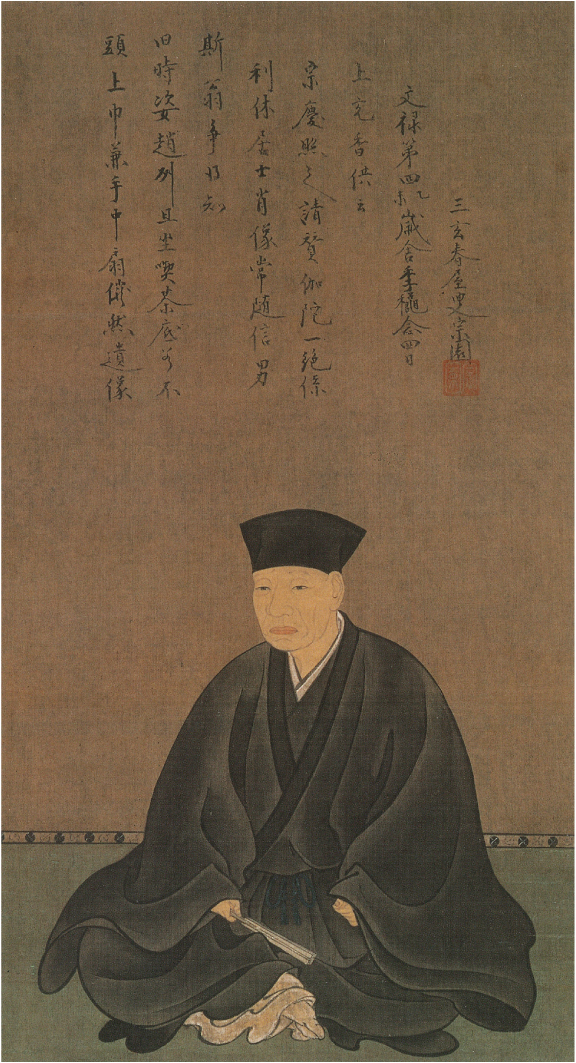
Sen no Rikyu (1522-1591)
Sen no Rikyu a vécu à une époque culturellement riche malgré les guerres. Sakai, ville natale de Rikyu, était urbainement plus développée que Kyoto. Après la guerre d’Onin, la population urbaine de Sakai, de Kyoto et de Nara est devenue l’acteur principal du développement culturel.
Cette population urbaine a alors pris goût à la vie campagnarde et a construit dans son jardin une petite hutte, à l’image de la « Soan » de Saigyo, pour y partager un espace-temps autour du thé avec ses invités.
Grandi parmi cette population, Rikyu est devenu entrepositaire à 19 ans suite au décès de son père et a commencé le Cha-no-yu.
Quand la ville de Sakai a été annexée au territoire d’Oda Nobunaga, Rikyu qui organisait des Chakai (rencontres autour du thé), a été nommé maître de thé.
Dans le cadre de la mise en œuvre par Oda Nobunaga d’une politique urbaine et économique, des maîtres de thé tels que Rikyu, Imai Sokyu et Tsuda Sogyu ont gagné une place importante : l’« âge d’or des maîtres de thé » a commencé.
Après l’assassinat d’Oda Nobunaga et la prise de pouvoir par Toyotomi Hideyoshi, ce dernier a gardé les trois maîtres de thé précités pour organiser des Chakai. Par la suite, Rikyu, qui était le troisième maître de thé, a été nommé premier maître de thé et est devenu le bras droit de Toyotomi Hideyoshi.
Après cette période de lune de miel, Toyotomi Hideyoshi a ordonné à Rikyu de se cloîtrer puis de se suicider. Personne ne sait exactement la cause de ce drame mais ce qui est sûr c’est sure qu’il s’est passé quelque chose qui a mis Toyotomi Hideyoshi en furie. On dit que c’est parce que Rikyu a trafiqué des ustensiles de thé, que Rikyu a critiqué la Chashitsu dorée de Toyotomi Hideyoshi, que Rikyu était trop orgueilleux, que Rikyu a refusé de donner sa fille à Toyotomi Hideyoshi, etc.
Après la mort de Rikyu, Hideyoshi a détruit la maison de Rikyu appelée Juraku-yashiki. La famille de Rikyu a été amnistiée par Tokugawa Ieyasu, ce qui a permis à trois petits fils de Sen no Shoan (gendre de Rikyu) de fonder les Trois écoles Senke (Omotesenke, Urasenke, Mushakojisenke).
Stylistic beauty mastered by Rikyu
The basic form invented by Rikyu is called "Rikyu-gata" and has been the standard for tea tools for the past 500 years. Some of them were made by Rikyu himself, some were designed by Rikyu, and some were made by others based on Rikyu's own preferences. However, in any case, the designs reflect Rikyu's aesthetic sense.
Eventually, these forms were copied and manufactured in large scale.

Esthétique stylistique perfectionnée par Rikyu
Depuis 500 ans, le style Rikyu-gata, exprimé dans les ustensiles que Rikyu a fabriqués, a choisis ou a fait fabriquer selon son goût, sert de référence en matière d’ustensiles de thé.
Certains ustensiles de Rikyu ont été copiés et ont fait l’objet d’une production en série.
Chashitsu
Chashitsu was not just a tea room, but an ideal home for the spirit and aesthetics of Cha-no-yu. Originally designed by city dwellers as a retreat in the mountains, it was not a place for many people to gather and make noise. In a small room with simplified decorations, the world of Wabicha, which allows for more intimate contact, was mastered, and that is how Yojo-han (4 and ½ tatamis) was born.
Chashitsu of tea Yojo-han, which is now the mainstream, also shows functional beauty in that people's movements and positions are determined according to the tatami mats laid on the floor.
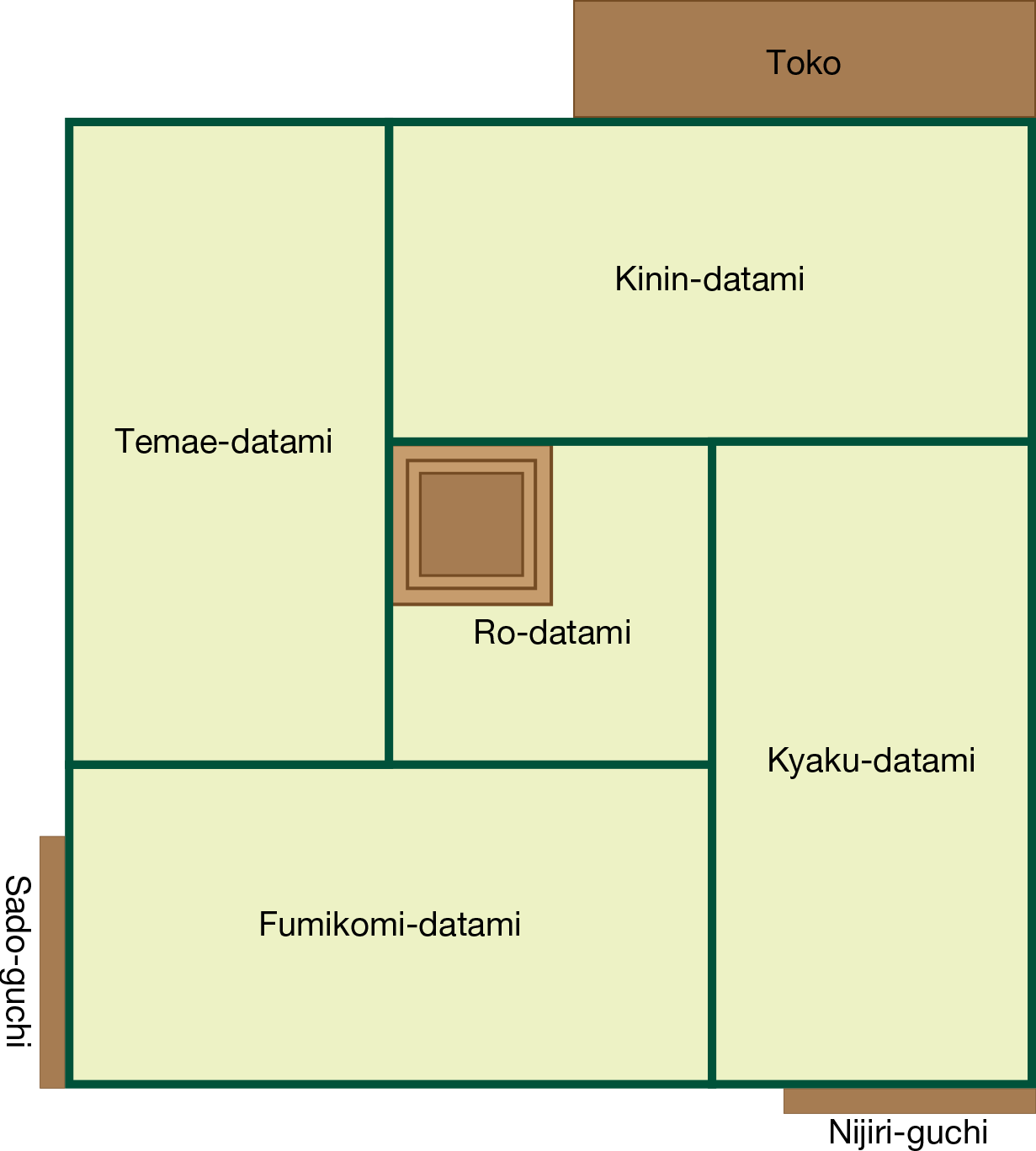
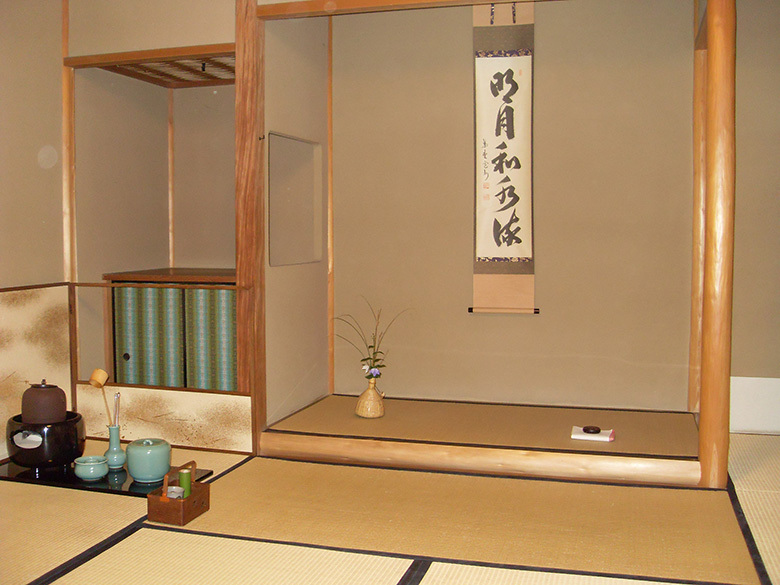
Chashitsu
Le Chashitsu n’est pas un simple un salon de thé mais un espace incarnant l’esprit et l’esthétique du Cha-no-yu. À l’origine, il s’agissait de petites huttes secrètes construites dans des zones rurales par des habitants des villes. La surface du Chashitsu a été réduite jusqu’à « Yojo-han » (4 et 1/2 tatamis) à force de vouloir simplifier les décorations et créer un espace incarnant l’esprit du Wabicha.
Les 4 et 1/2 tatamis d’un Chashitsu déterminent le positionnement et les gestes des invités. Quelle esthétique fonctionnelle !
Temae
The series of actions in which the master makes tea in front of the guests is called "Temae". Temae represents concentration of spirit, purification, and respect, which are considered formal beauties of Cha-no-yu.
Temae
Temae désigne l’ensemble des gestes de l’hôte préparant du thé devant ses invités et incarne l’esthétique stylistique du Cha-no-yu exprimant l’harmonie, la pureté et le respect.
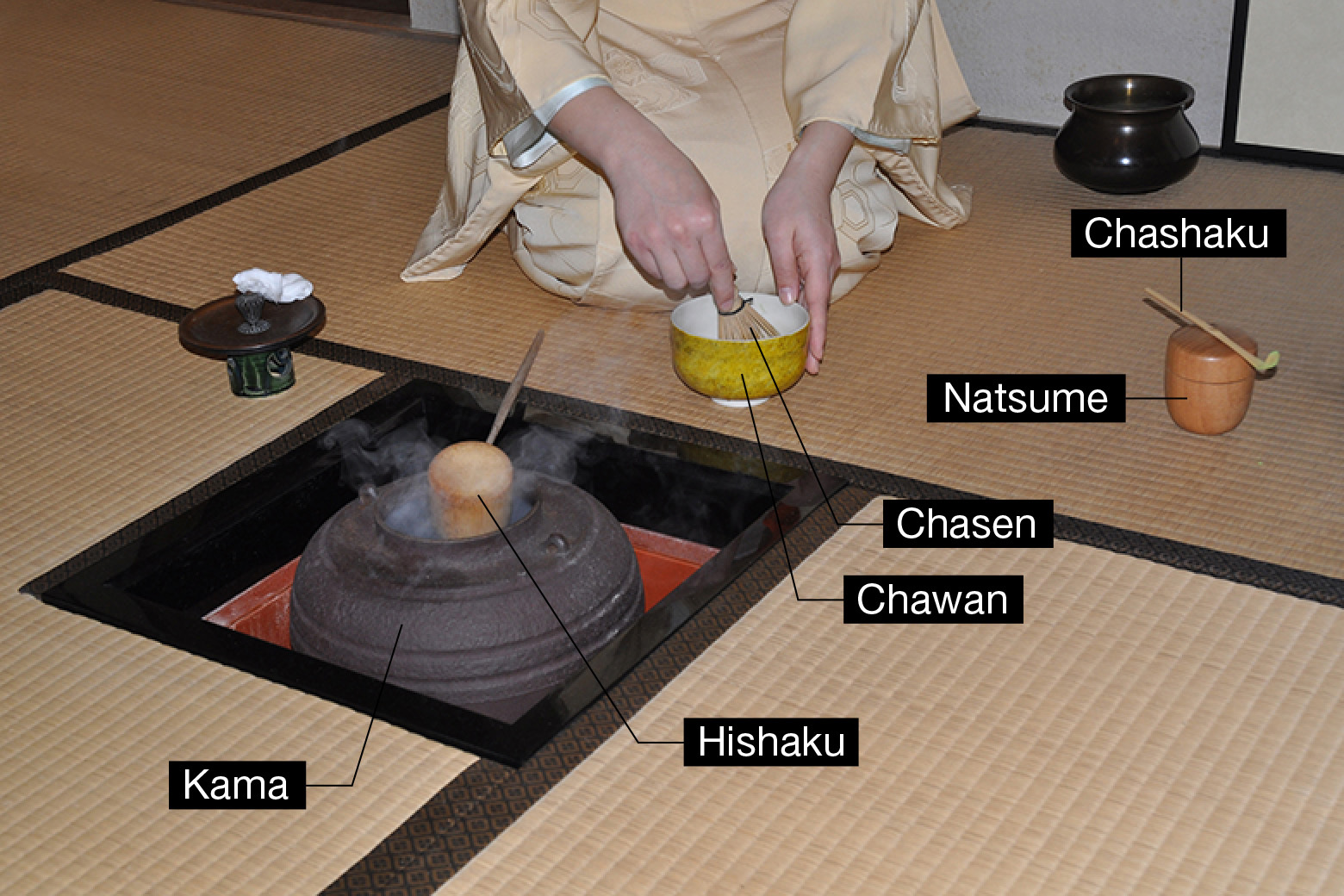
Details of tea tools
The master of Chakai has a theme for Chakai which is reflected in the tea tools.
Chawan (tea bowl)
"Ichiraku, Nihagi, Sankaratsu" is the ranking of tea bowls suitable for Chakai, and Raku tea bowls were made exclusively for Cha-no-yu and reflect the designs of Rikyu. It is one of the most popular tea tools today.
Chaire (Cha-ire)
A cup used to hold matcha for strong tea. In Rikyu's time, it was mainly Chinese, but Japanese Setoyaki is also popular.
Natsume
A cup used for holding matcha for weak tea. Many are made of lacquered or wooden materials. There are various types, including decorative ornate ones with Makie or Kuronatsume.
Shifuku
Bags for Chaire
Chashaku (scoop)
In the past, Chajin made them by themselves. Many of them have names attached to them. These tools are said to represent the spirit of Chajin.
Hishaku
A tool for pouring hot water from Mizusashi or Kama, made of bamboo.
Chasen
A tool for making matcha, made of bamboo.
Kama
A tool for boiling water, made of iron.
Mizusashi
A bowl placed near Kama to hold the water needed for Chaseki.
Ro
A portable device for boiling water using Kama, used from November to April.
Furo
Ro used from May to October.
Hanaire
A pot used to hold flowers to be arranged at Chaseki.
Kakemono / Kakejiku
A painting or calligraphy that is hung in the Tokonoma for viewing. It is hung according to the theme of Cha-no-yu and is an important item for Chakai.
Tanamono
A shelf to put tools and decorate.
Kashiki
A plate for sweets
Fukusa
A cloth used to clean the Chashaku and tea tools.
Kobukusa
A cloth with a pattern, such as Kinran, Donsu or Kanto, used to hold the tools when serving tea.
Kogo
A small bowl for holding Ko.
Ustensiles
L’hôte choisit les ustensiles à utiliser en fonction du thème.
Chawan (bol à thé)
« Raku en premier, Hagi en deuxième et Karatsu en troisième », c’est un dicton concernant le classement des meilleurs bols à thé pour le Cha-no-yu. Les bols de Raku sont fabriqués uniquement pour le Cha-no-yu et suivant le goût de Rikyu. C’est le must des Chawan même à ce jour.
Chaire (Cha-ire)
C’est un pot à thé pour le Matcha (thé vert en poudre) dense. Les Chaire importés de Chine avaient du succès à l’époque de Rikyu. Les Chaire de Seto sont toujours appréciés de nos jours.
Natsume
C’est une boîte à thé pour le Matcha léger. Laqué, en bois naturel, avec Makie, tout noir… il y en a de toutes sortes.
Shifuku
Il s’agit d’une pochette pour le Chaire.
Chashaku (cuillère à Matcha)
Autrefois, les Chajins fabriquaient les Chashaku (cuillères à Matcha) eux-mêmes. Certaines ont un nom. On dit que les Chashaku représentent les âmes des Chajins.
Hishaku
Louche pour prendre de l’eau chaude
Chasen
Fouet à Matcha en bambou
Kama
Bouilloire en fonte
Mizusashi
Pot à eau disposé à côté de la Kama
Ro
Foyer portatif pour chauffer l’eau, utilisé de novembre à avril
Furo
Foyer utilisé de mai à octobre
Hanaire (Hana-ire)
Vase à fleur
Kakemono / Kakejiku
Peinture ou calligraphie destinée à être accrochée sur le mur du Toko. L’hôte choisit un Kakemono en fonction du thème du Cha-no-yu qu’il organise. Un élément important pour une Chakai.
Tanamono
Tablette pour poser les ustensiles
Kashiki
Plateau et bol pour gâteaux
Fukusa
Tissu pour purifier la Chashaku, etc.
Kobukusa
Tissu sur lequel on pose le bol à thé avant de servir et d’admirer le bol. Il existe différents motifs tels que Kinran, Donsu, Kando, etc.
Kogo
Boîte à encens


